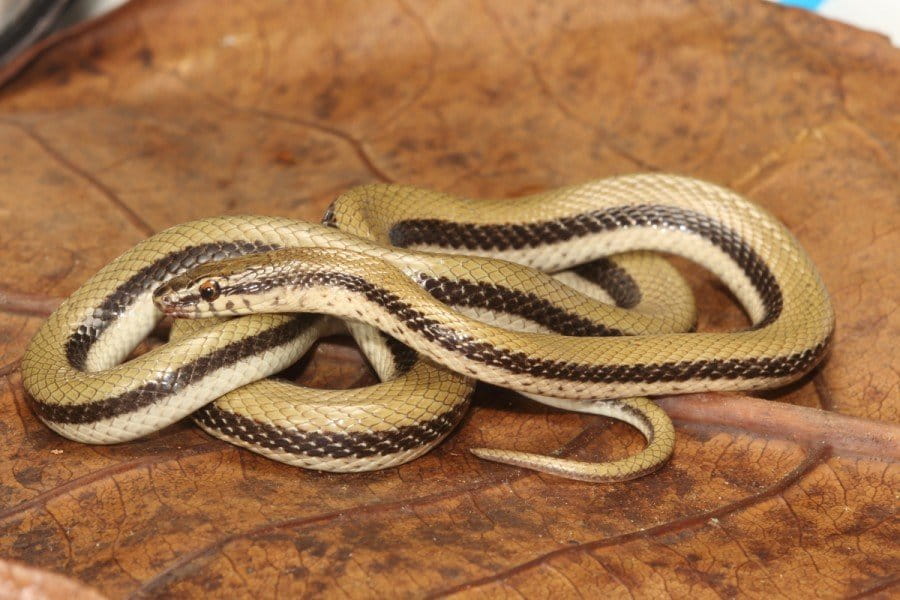- India is home to about 280 species of snakes, and it is generally assumed that the reptiles of India had been thoroughly documented decades ago.
- “Discovery of Wallaceophis gujaratensis further adds to the growing knowledge of the high degree of unique and endemic herpetofauna in the country and also brings to light the poor nature of herpetofaunal documentation in the country,” researchers write.
- The new species was named Wallaceophis gujaratenesis after Alfred Russel Wallace, a British naturalist, explorer, and biologist known for independently discovering the theory of natural selection at the same time as Charles Darwin, and Gujarat, the state where the snake was discovered.
A new snake belonging to the Colubridae family has been found in Gujarat, India and researchers say it not only represents a new species but also a new genus.
The new species was named Wallaceophis gujaratenesis after Alfred Russel Wallace, a British naturalist, explorer, and biologist known for independently discovering the theory of natural selection at the same time as Charles Darwin, and Gujarat, the state where the snake was discovered.
The first live specimen of the snake was found in 2014 at a construction site in a shallow pool of water by Jaydeep Maheta, a “snake rescuer” with the Shree Cultural Foundation in Gujarat.
Zeeshan Mirza of the National Centre for Biological Sciences in Bangalore, India, the lead author of a PLOS One article describing the new species and genus, said that he and his co-authors, which include Maheta, had been on the lookout for the snake since at least 2007. The researchers had seen photographs of Wallaceophis gujaratensesis, and though it resembled the Indian smooth snake (Coronella brachyura), it had two lateral stripes that caught their attention.
After seven years, Mirza and team finally had the live individual they needed to determine the snake’s identity by examining its scales and dental morphology. Mirza found a scale usually present in racer snakes, as well as a unique pattern of scales on the specimen’s back that clearly separated it from most non-venomous snakes in the Colubridae family.

Mirza shared his findings with Raju Vyas, a herpetologist with extensive experience in Gujarat who had first brought photographs of the snake to Mirza’s attention. Vyas, it turned out, had received new photographs of the snake from several localities across Gujarat, as well as two dead specimens sent to him by colleagues.
“Morphology of the jaw bones and vertebrae confirm that the snake indeed was a member of the group of racers, but did not match any known species, nor could it be accommodated in any known genus,” Mirza said in a statement sent to Mongabay.
India is home to about 280 species of snakes, and it is generally assumed that the reptiles of India were fairly well documented decades ago, the authors note in the article. But several new species of reptiles have been described in India in recent years, they write, “highlighting the need for more dedicated surveys across the country.”
Specifically, they say, the forests of Gujarat, the western-most state in India, are relatively unexplored by herpetologists. They point to the discovery of a new gecko, H. gujaratensis, as another example of recent additions to the known reptile species of Gujarat.
“Discovery of Wallaceophis gujaratensis further adds to the growing knowledge of the high degree of unique and endemic herpetofauna in the country and also brings to light the poor nature of herpetofaunal documentation in the country,” the researchers write.
Mirza said that more dedicated surveys to document biodiversity across Indian landscapes that have previously been considered less biodiverse would likely find many overlooked species.
“A large number of projects and expeditions are carried out in biodiversity hotspots like Western Ghats and northeast India but our finding highlights the need to divert funding and efforts to other less explored areas of India as well,” Mirza added.
“With the exception of mammals and birds among vertebrates and a few invertebrate groups like butterflies, we are far from having a complete understanding of our biodiversity.
CITATION
- Giri, V., Bauer, A., Vyas, R., Patil, S. (2009). New species of rock-dwelling Hemidactylus(Squamata: Gekkonidae) from Gujarat, India. J Herpetol 43: 385–393. doi: 10.1670/08-137r1.1
- Mirza, Z.A., Vyas, R., Patel, H., Maheta, J., Sanap, R.V. (2016). A New Miocene-Divergent Lineage of Old World Racer Snake from India. PLoS ONE 11(3): e0148380. doi:10.1371/journal.pone.0148380